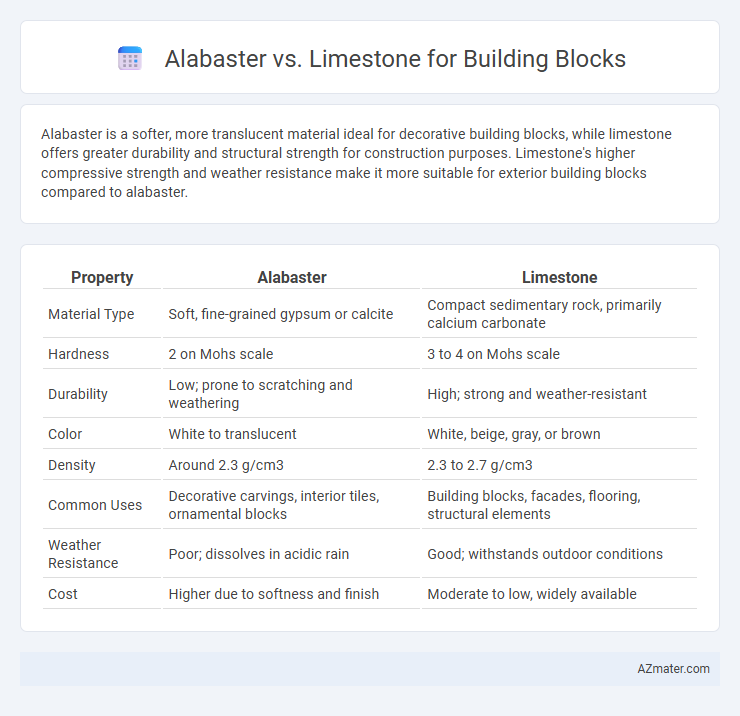Alabaster is a softer, more translucent material ideal for decorative building blocks, while limestone offers greater durability and structural strength for construction purposes. Limestone's higher compressive strength and weather resistance make it more suitable for exterior building blocks compared to alabaster.
Table of Comparison
| Property | Alabaster | Limestone |
|---|---|---|
| Material Type | Soft, fine-grained gypsum or calcite | Compact sedimentary rock, primarily calcium carbonate |
| Hardness | 2 on Mohs scale | 3 to 4 on Mohs scale |
| Durability | Low; prone to scratching and weathering | High; strong and weather-resistant |
| Color | White to translucent | White, beige, gray, or brown |
| Density | Around 2.3 g/cm3 | 2.3 to 2.7 g/cm3 |
| Common Uses | Decorative carvings, interior tiles, ornamental blocks | Building blocks, facades, flooring, structural elements |
| Weather Resistance | Poor; dissolves in acidic rain | Good; withstands outdoor conditions |
| Cost | Higher due to softness and finish | Moderate to low, widely available |
Understanding Alabaster and Limestone
Alabaster is a fine-grained, translucent form of gypsum or calcite known for its softness and smooth texture, making it ideal for detailed carving and decorative building blocks. Limestone, composed primarily of calcite, is a sedimentary rock noted for its durability and versatility in construction, often used in foundational blocks and exterior facades. Understanding the mineral composition and physical properties of alabaster and limestone helps architects and builders select the appropriate material based on aesthetic needs and structural requirements.
Geological Formation and Composition
Alabaster, a fine-grained form of gypsum or calcite, forms through evaporative sedimentary processes in shallow marine environments, resulting in a softer, more translucent stone ideal for detailed carving. Limestone predominantly consists of calcite or aragonite, created from accumulated marine organism shells and skeletal fragments in warm, shallow seas, yielding a denser, more durable material suited for structural building blocks. The mineralogical differences, with alabaster's gypsum or calcite composition versus limestone's primarily calcite content, directly influence their respective hardness, porosity, and weathering resistance in construction applications.
Visual Appearance and Texture Comparison
Alabaster exhibits a smooth, translucent surface with a fine-grained texture that enhances its elegant, soft appearance, often favored for intricate carvings and interior decorative elements. Limestone, by contrast, has a coarser, more porous texture with a matte, natural finish that highlights its earthy tones and weathered aesthetic, making it well-suited for robust exterior applications. The visual contrast lies in alabaster's lustrous sheen and subtle translucency versus limestone's rugged, grainy consistency and solid coloration.
Durability and Strength in Construction
Alabaster offers moderate strength and is softer compared to limestone, making it more suitable for decorative purposes rather than structural applications. Limestone exhibits higher durability and compressive strength, often ranging from 30 to 250 MPa, making it a preferred choice for load-bearing construction blocks. Its resistance to weathering and impact ensures long-term stability in various architectural projects.
Workability and Ease of Carving
Alabaster offers superior workability and ease of carving compared to limestone due to its softer texture and finer grain, allowing for intricate details and smoother finishes. Limestone, while durable, is harder and more abrasive, requiring specialized tools and more effort to achieve detailed carvings. Sculptors and builders often prefer alabaster for decorative elements and detailed work, whereas limestone is favored for structural applications needing greater strength.
Weather Resistance and Longevity
Alabaster, composed primarily of gypsum, is softer and less weather-resistant compared to limestone, which is a sedimentary rock rich in calcite. Limestone exhibits greater durability and longevity in exterior applications due to its higher resistance to erosion, chemical weathering, and freeze-thaw cycles. Buildings constructed with limestone blocks typically endure harsh climates better and maintain structural integrity over longer periods than those using alabaster.
Cost and Availability of Building Blocks
Alabaster is generally more expensive than limestone due to its rarity and the labor-intensive extraction process, making it less accessible for large-scale construction projects. Limestone is widely available and cost-effective, sourced from abundant sedimentary deposits, which lowers transportation and procurement costs for building blocks. Builders often choose limestone over alabaster for budget-sensitive projects because of its consistent supply and affordability.
Common Architectural Applications
Alabaster, valued for its fine grain and translucency, is commonly used for intricate interior elements such as decorative panels, sculptures, and ornamental details in buildings. Limestone, noted for its durability and versatility, serves widely in exterior cladding, load-bearing walls, and paving due to its strength and weather resistance. Both materials are integral in architectural applications, with alabaster emphasizing aesthetic appeal and limestone providing structural functionality.
Environmental Impact and Sustainability
Alabaster, a softer, more delicate stone primarily composed of gypsum, has a lower environmental impact during extraction due to its ease of quarrying and reduced energy consumption compared to limestone. Limestone, a sedimentary rock primarily made of calcium carbonate, often requires more intensive mining and processing, resulting in higher carbon emissions and landscape disruption. Choosing alabaster over limestone can enhance sustainability in building projects by minimizing resource depletion and reducing carbon footprints associated with material production and transportation.
Choosing the Right Stone for Your Project
Alabaster offers a softer, more translucent quality ideal for decorative interiors, while limestone provides superior durability and weather resistance, making it suitable for exterior construction. Consider the project's location and exposure; limestone withstands harsh environmental conditions better, whereas alabaster's aesthetic appeal enhances indoor applications. Assessing factors like hardness, porosity, and maintenance requirements will guide the selection of the appropriate stone for lasting performance and desired visual impact.

Infographic: Alabaster vs Limestone for Building Block
 azmater.com
azmater.com